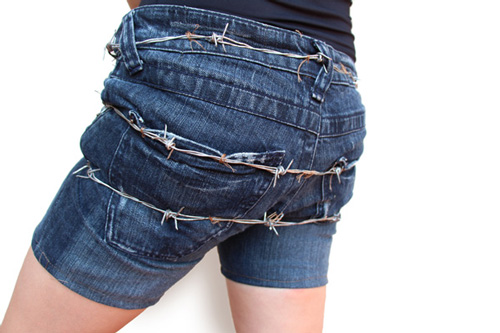
MDP Student Barb Natali designed these “barbed-shorts” to provoke dialogue about gender relations in Uganda
Last fall I spent six weeks in Uganda as part of the Media Design Practices program. While there, a few classmates and I attended a crowded performance and had multiple, local men inappropriately grab us as we attempted to navigate the throng. I caught one teen in the act and yelled at him. He grinned at me during the tirade, but was for the most part unfazed.
A few days later when the anger subsided, I reflected on the experience. The incident had provoked questions about the interactions and power dynamics between men and women in Uganda. In order to develop an understanding of these aspects of the society I decided to create a series of designs to facilitate conversations about Ugandan experiences, reactions, and negotiations of the dynamics between men and women, specifically in regard to sexual harassment and inequality.

Barb Natali’s undergarments require the wearer to suffer to be safe.
My preliminary prototype consisted of women’s undergarments studded with sewn-in tacks. I tested and iterated a number of times on this design, which culminated in a variety of garments wrapped in barbed wire. The barbed wire garments were particularly successful at inciting conversations for a number of reasons. First of all, they provided something tangible and controversial as a means of evoking a response. In Uganda barbed wire lines the tops of many buildings and walls to deter trespassers. These barbed wire garments suggest a similar protection of property, and corresponding consequences for violators. On the flip side, the garments materialize the idea that to protect yourself, you risk harming yourself. For instance, I incurred multiple wounds from wearing and handling the skirts. Lastly, the designs embody a certain amount of absurdity and humor that was successful in making people more comfortable and open to discussing sensitive issues.
I deployed these prototypes in a variety of public and private settings and within individual as well as group contexts. The objects incited various conversations about sexual harassment, victim blaming, rape within a marriage, power dynamics within relationships, and many other topics regarding male and female relations. The most informative conversation I witnessed occurred within a small group of Makerere University students. They had just finished a dance rehearsal, had eaten dinner, and were sitting around relaxing and chatting. When there was a lull in the conversation I asked for people’s opinions regarding my designs.
The result was an intense debate about male and female dynamics within clubs. One of the guys stated, “The majority of girls go to the club because they want to be touched… If they don’t touch them they will feel so bad.” This evoked a series of retorts from the women and the explanation, “You think having fun is men touching you? That is not having fun.” The debate continued for around an hour and became more heated, while managing to stay friendly. It was a productive forum for male and female students to express opinions and for me to learn about some of the local expectations and behaviors that take place within Ugandan clubs. Highlights from the conversation can be viewed here.
The Ugandan students also communicated their feelings about these tensions with spellbinding eloquence in the video below, which Natali captured as they performed a song written as part of a collaboration between Media Design Practices students and homeless youth from Jovenes Inc.
Makerere Dancers from Barb Natali on Vimeo.
By employing design, iteration, and field prototypes I had the opportunity to work closely with communities and individuals to develop a rough understanding of the realities of male and female dynamics within Uganda. Additionally, these designs generated dialogues in which men and women could openly express their experiences, views, and responses to interactions between the sexes and the potential inequalities that may result. When I return to Uganda in February I will be continuing to utilize design to explore and examine these types of issues and their implications within the society.








